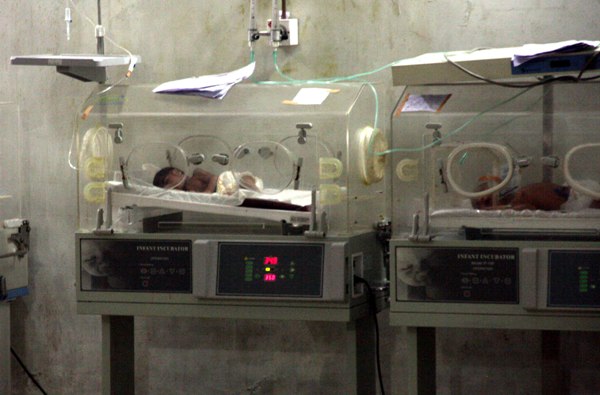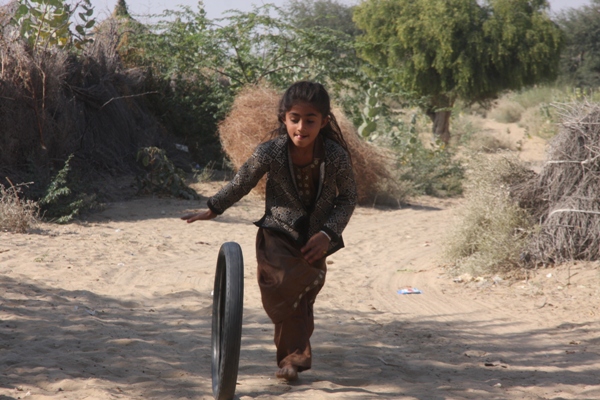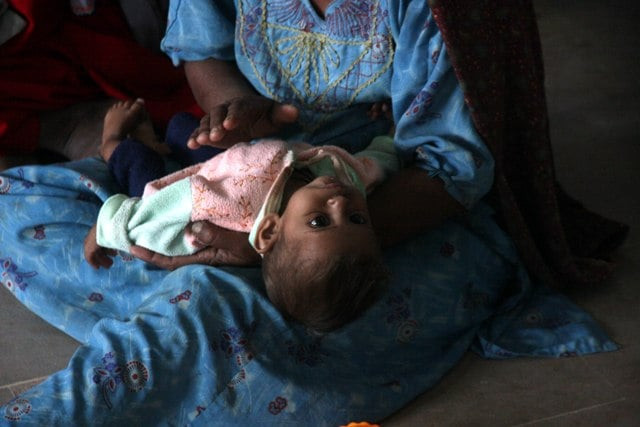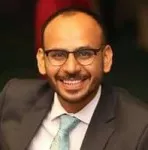My unwavering excitement for the trip rid me of any sleep the night before. Even the scenery along the route was so ruthlessly captivating that I couldn’t catch a wink on the way either. My team and I drove on smooth roads along vast agriculture fields and large industries. However, I would have enjoyed the scenery a lot more had my mind not been preoccupied with thoughts of the mass deaths of children and the horrifying images of hunger-struck people at the place we were heading to.
At around two in the afternoon, we reached Mithi – a developed urban centre with an estimated population of 38,000 people, a majority of whom are Hindus. Like the rest of the district, religious harmony is apparent and the crime rate is nearly zero.
We are led to a guest house so lavish that I have a hard time believing it’s situated in the desert. I was sipping my second glass of orange juice when a news report flashed across the television screen claiming that four more children had died at Civil Hospital, Mithi. My sweet drink suddenly tasted bitter.
“Where is this hospital?” I asked Suhail, who drove my team from Karachi.
“It is downtown, around two kilometres away,” he said.
My team and I got up to leave immediately.
It’s not easy navigating the streets of Mithi where cows, revered by the Hindu community, roam freely at any given time of the day and often cause traffic jams. But we managed to reach our destination soon.
One and only health facility
 Photo: Athar Khan/Express
Photo: Athar Khan/ExpressCivil Hospital, Mithi, is small with only two building blocks, yet it’s the largest health facility catering to the 1.5 million people spread over 3.4 million acres of Tharparkar district. Men clad in untidy clothes and women dressed in traditional colourful saris were walking around the premises, sometimes sitting to chat with other attendants. The temperature soared and there were only a few trees providing relief.
I sat down to chat with the medical superintendent, Dr Iqbal Ahmed Bhurgari, at his office.
“What are the reasons behind these deaths?” I asked him.
“There are several (reasons),” he responded.
“Pneumonia, diarrhoea and complications from premature births,” he listed some of them.
“What did the four children suffer from?”
I asked him, the news of the four recent deaths still fresh in my mind.
“Which four children?” he asked, looking perplexed.
“The ones who just died in this hospital,” I tried to explain.
“There were no deaths today,” he asserted confidently and then showed me hospital records.
Twenty-one days into the New Year and 31 children had died at the dingy little hospital in Mithi, the doctor said. Most of them were half dead when they were brought in, the rest were in critical condition. Around 40 children were still undergoing treatment. The patients came from far-flung areas, he explained.
“Most of the children are suffering from stunted growth due to what their mothers ate when they were pregnant,” he added.
Dr Bhurgari goes on to list the facilities that Civil Hospital, Mithi, offers.
“There are 49 doctors at this 90-bed hospital. Four paediatricians, three gynaecologists and 15 women medical officers working round the clock in shifts,” he said.
“The hospital has a fully equipped nursery with incubators.”
He was confident that since there was no drought prevailing at the moment, the situation was not as dangerous as it had been in the past.
 Photo: Athar Khan/Express
Photo: Athar Khan/Express Photo: Athar Khan/Express
Photo: Athar Khan/ExpressThe rosy picture that Dr Bhurgari painted did not support the four deaths that had been reported within the same hospital by multiple television channels just a few hours earlier. I walked around the wards hoping to verify the deaths with the attendants but had no luck.
“Mukhay khabar konhe,” (I don’t know) said Faizu, who was attending to his one-year-old daughter.
I asked him if he saw anyone taking a body or crying. He hadn’t.
As I spoke to the patients’ attendants, I realised it was a miracle that the death toll was not much higher. There are hardly any ambulance services in the desert, so patients are transported to Mithi hospital on Kekras (customised American trucks that are being used as public transportation in Tharparkar for decades), private keeps and more recently Qingqis.
Believe it or not
The hospital failed to provide any confirmation about the four deaths, so I decided to contact a local journalist over the phone.
“Nine children died today – four at Civil Hospital and five others at different location,” he insisted.
He added that the hospital administration cannot be relied on for accurate information.
“The hospital has been asked (allegedly by the Sindh government) to hide the news of death from the media,” he said.
The next day, our team headed out to various villages lying outside Mithi, hoping to verify the reports of drought and children’s deaths.
“Food and water have always been scarce,” said Mota, an elderly person in a village 30km away from Mithi.
“We rely on rain water. We store it for potable use as the water drawn from the wells is saline.”
“The desert blooms when it rains and withers when it does not,” said Khameso, a white-bearded person in his 80s.
“When the land gets enough water, the trees and plants grow their leaves giving the animals their favourite fodder,” he explained.
“People don’t have enough resources to buy fodder from the market,” he added.
“Khud khae ga ya maal ko khilae ga” (People can either feed themselves or feed their cattle.)
We went around 10 villages made of mud huts, with roofs made of bushes, but were unable to verify the four deaths. Most residents insisted that the situation had improved. They had enough water and food to keep the wheel of life spinning.
 Photo: Athar Khan/Express
Photo: Athar Khan/ExpressI visited parts of Islamkot – another city in Tharparkar district that according to the locals was earlier known as Ramkot – but still failed to find the four families whose children the media had confidently reported dead.
The desert lifestyle is far from comfortable, but this visit forced me to take media reports from the area with a grain of salt.



COMMENTS
Comments are moderated and generally will be posted if they are on-topic and not abusive.
For more information, please see our Comments FAQ